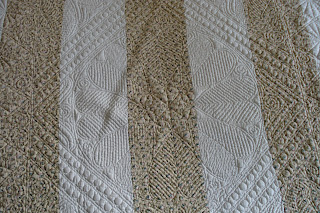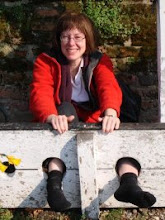



This quilt was sold as a Durham strippy. But one look at the poor photos was enough to know that this was a Welsh strippy. How to tell the difference?
According to Dorothy Osler, British Quilts, Welsh strippies generally have wider strips than North Country strippies. In both, the strips are pieced by machine. Durham strippies have border designs quilted along the strips, whilst in Welsh strippies the strip quilting format was rare. Here the quilting disregards the strip piecing and the standard bordered layout with central and corner motifs with one or more borders is followed. Welsh quilts have broad even strips in contrasting colours, with odd numbers of strips.
Strip quilts were made in great numbers during the years 1869-1930 and seem to have been the “everyday” quilts. Fizrandolph indicated high proportions of strippies being made. Few survive, so it seems that they were more used and therefore more liable to destruction. Wholecloth quilts were the more valued “best” quilts, were more likely to be preserved and thus more survive. See also The Classic Strippy Quilt – D. Osler Quilt Studies Volume 1(1999).
This quilt has beautiful quilting and must have been “for best” as it seems little used. The strips are 9” wide, and there are an odd number which are reversible – i.e. the other side has the opposite colour. Strip quilts were easily put together by machine. Here a plain white cotton sateen is paired with a pink blue and green flowered print. The wadding is carded wool. The date is hard to guess as the fabric is not distinctive – it could date from the 1890’s. The quilting patterns are especially nice on this quilt – the central medallion is of lined hearts. In the corners there is a nice tulip motif and also a flower within a circle. Also seen are circles drawn from coins (too small for pennies – farthings?), spirals, and a lovely church window border. All closely quilted.
This quilt was on display at the summer 2008 Minerva exhibition of antique Welsh quilts in Llanidloes, along with my red and blue flannel quilt. Also, at the Quilters Haven exhibition over Easter 2008.
This quilt has no provenance but the seller did come from Carmarthen.
“In Wales, quilting was a cottage industry and quilts were made to be sold, quilters seldom signed them. Provenance is therefore a rarity. It was not false modesty that prevented the quilters from signing their work. Conceiving what they did as a utilitarian service, it would not have occurred to them to claim credit for their accomplishments. (Jen Jones)

amazing stuff!
ReplyDeleteI am drooling over your Welsh quilts - such wonderful geometric patterns - totally different to the flowing North Country motifs.
ReplyDeleteI also love the way they quilted their usual medallion style pattern over the strippy patchwork. So very at odds with the modern desire to make everything fit together.
I am quite sure I will use these patterns for one of my own quilts one day...thank you for reminding me, Pippa!
ReplyDeleteThis is not an uncommon occurrence. the pre printed Wholecloth quilt tops sold by Benartex as a Welsh Beauty Style no 780 is completely North Country or Durham in Design.
ReplyDelete